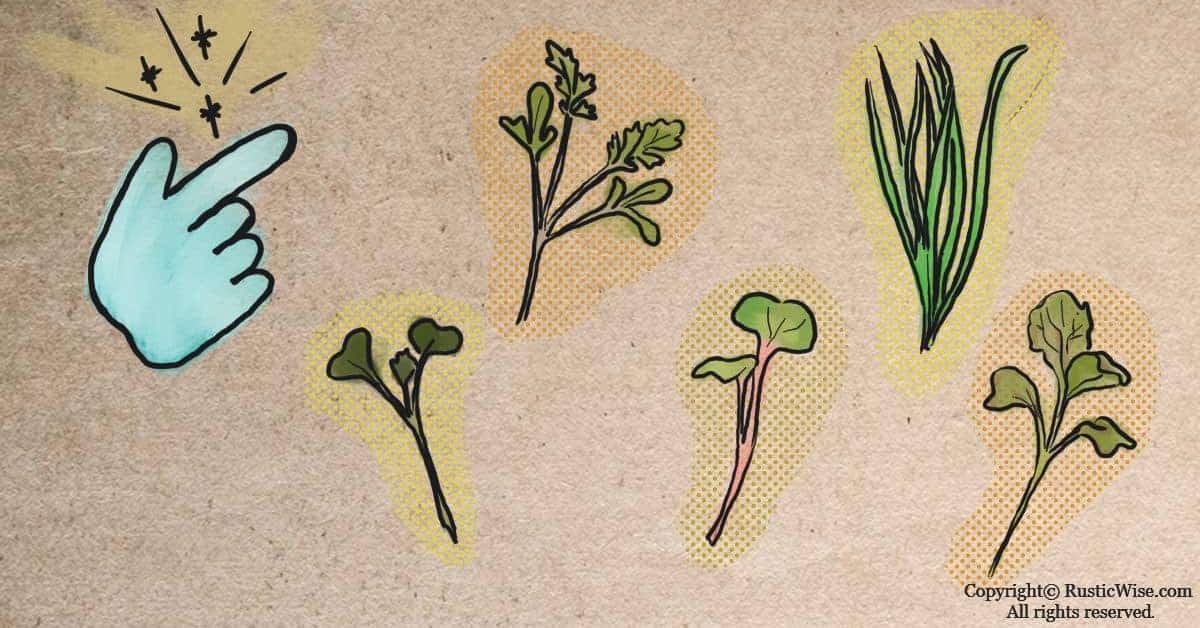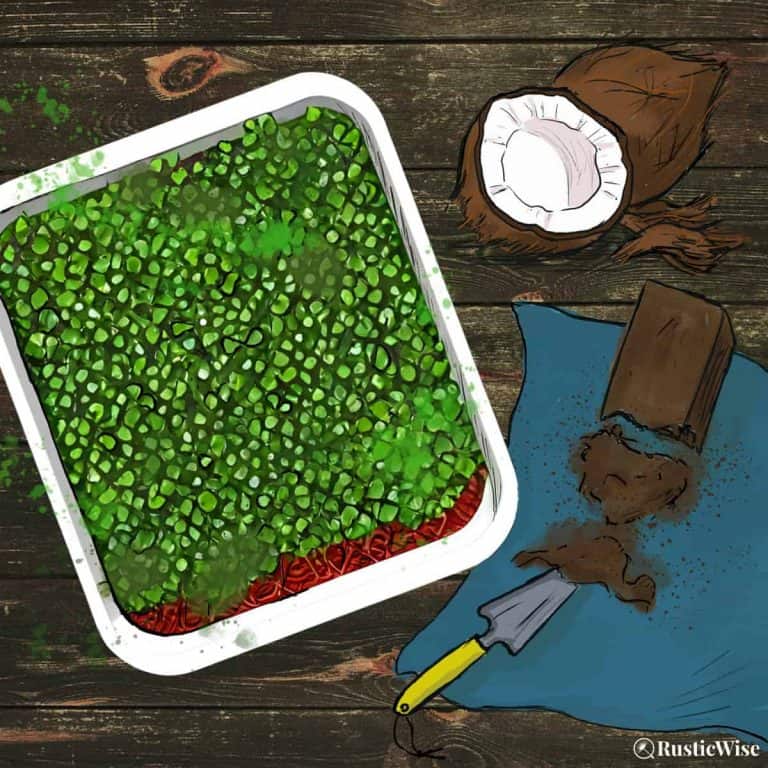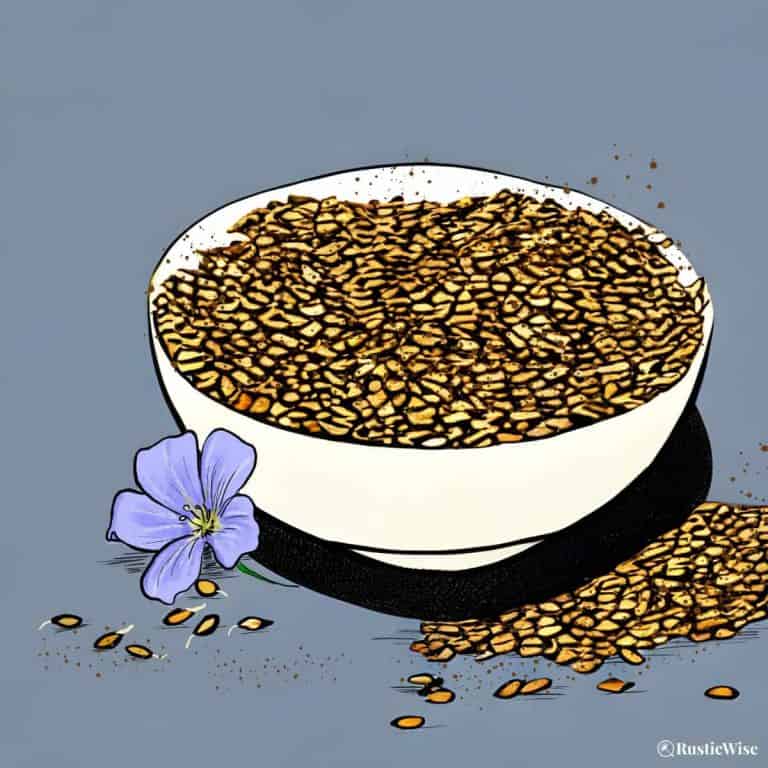13 Easiest Microgreens To Grow
RusticWise is supported by its readers. When you purchase through links on our site, we may earn an affiliate commission. As an Amazon Associate, we earn from qualifying purchases. Thank You!
Microgreens are a great way to add fresh, new flavors to your favorite dishes. But not all microgreens are easy to cultivate—especially if you’re new to growing microgreens. We’ve rounded up a list of the top 13 easiest microgreens to grow based on easy germination, time to harvest, and overall taste or usability. We’ll also go over a few microgreens you should avoid growing.
Microgreens are a great source of high density nutrients and something you can grow indoors year-round. There are so many varieties of microgreens to choose from—check out the seeds that should give you the best chance at success! We’ve also rounded a few that are slightly more challenging to grow.
Microgreens to avoid growing
There are so many types of microgreens to grow including vegetables, herbs, grains, and legumes—it can be hard to decide which ones to start with. Almost any type of crop or edible plant can be grown as a microgreen.
There are always exceptions of course.
Here are a few types of microgreens you should avoid or use caution for health and safety reasons.
- Members of the nightshade family: The nightshade family includes eggplant, goji, tomatoes, potatoes, and peppers. While it’s perfectly safe to eat the mature fruits or vegetables from these plants, the young shoots or microgreens contain high levels of solanine and tropanes which are poisonous when ingested.
- Buckwheat greens: While you’ll find buckwheat and buckwheat sprouts for sale, buckwheat microgreens have some safety concerns (2). This is because the raw microgreens contain high levels of a pinkish toxin called fagopyrin. People who have consumed large amounts of raw buckwheat from juicing, for example, have reported developing a skin rash. Livestock that ingest large amounts of buckwheat plants also suffer from similar conditions. Buckwheat sprouts (which are repeatedly rinsed throughout the growing cycle) get rid of the pink toxin; sprouts are different than microgreens. Buckwheat when cooked, is also safe. Despite these safety concerns, many still grow and enjoy this micro in moderation.
13 Easiest microgreens to grow
Whether you’re new to microgreens, or have experienced a batch or two of bad microgreens, here are 13 of the easiest microgreens to grow. (Because everyone wants to have a successful harvest, right?)
You’ll notice that many of the easiest microgreens to grow belong to the Brassica family (cabbage, broccoli, and mustard). It’s true that many Brassicas are tasty and fairly foolproof to grow as microgreens.
This list is based on ease of germination, relatively shorter time to harvest, and best overall taste or usability.
This roundup of easiest microgreens to grow (along with more challenging microgreens to grow, see below) is based on some info from the book, Microgreen Garden: Indoor Grower’s Guide to Gourmet Greens by Mark Mathew Braunstein. This book is a great resource if you want to take a closer look at growing microgreens at home. We’ve also added a few more microgreens to the list.
Let’s dive in!
Table 1: Easiest Microgreens To Grow
| Microgreen | Time to Harvest | Growing Characteristics | Taste and Use |
|---|---|---|---|
| Napa cabbage | 8–12 days | Quick and easy to grow; high germination. | Mild cabbage flavor that works well as part of a salad, or as a base green all on its own. |
| Radish | 6–14 days | Quick and easy to grow. | Spicy and crunchy, many radish varieties that range from green with white stems to crimson and deep purple. |
| Broccoli | 5–14 days | Quick growing; it’s important to bottom water these to avoid bacteria problems at the roots. | Mild, slightly spicy flavor that works well with most dishes. |
| Turnip | 7–14 days | Quick and easy to grow; does fine in indirect light. | Mild, sweet and slightly tangy flavor—very similar to cabbage. |
| Bok choy | 8–11 days | Quick and easy to grow; does fine in lower light. | Fresh and mild flavor that’s slightly sweet, yet earthy. |
| Pea shoots | 8–12 days | Quick and easy to grow; high germination rates. | Crunchy and slightly sweet; makes a wonderful salad base. |
| Cress | 7–14 days | Fast grower; cress is a mucilaginous seed. | Spicy, use sparingly as a garnish. |
| Lettuce (romaine) | Less than 14 days | Fragile after harvest; quick germination even in cooler temperatures. | Mild, agreeable flavor; use just as you would full-grown romaine lettuce. |
| Komatsuna | 8–12 days | Grows rapidly and evenly; tolerates heat and cold; avoid overcrowding the seeds. | Milder mustard flavor. |
| Sesame | 7–10 days | Germinates quickly. | Slightly nutty and mild flavor. |
| Endive | 8–15 days | Easy to grow; tolerates colder temperatures. | Mild flavor with a slightly bitter aftertaste. |
| Mustard | 7–8 days | Quick and easy to grow; grows uniformly. | Bold, intense flavor similar to horseradish; use in small quantities as a garnish. |
| Wheatgrass | 6–10 days | Quick and easy to grow. | Fresh and intense flavor; great in smoothies or juices. |
1) Napa cabbage microgreens
- Time to harvest: 8–12 days
- Quick and easy to grow; high germination
Napa cabbage, sometimes called Chinese cabbage is a great microgreen to grow for beginners. Not only is it nutritious (high in vitamin A, C and K), but it’s also one of easiest microgreens to grow with a quick harvest time.
With a mild cabbage flavor that works well as part of a salad, or as a base green all on its own. Not surprisingly, the microgreens have similar coloring to its mature counterpart with pale green leaves and light-green to white stems.
2) Radish microgreens
- Time to harvest: 6–14 days
- Quick and easy to grow
While there are many varieties of radishes, daikon and red radish are especially great and easy to grow. Daikon microgreens have a white stem with pale green leaves, while red radish microgreens can range from crimson to deep purple.
Like the full-grown version of the plant, radish microgreens bring the spice! Add radish microgreens to dishes for added crunch and a peppery taste.
Radish microgreens are rich in vitamins C, E, and K. A 2012 study from the Agricultural Research Service (ARS) from the U.S. Department of Agriculture (USDA) along with the University of Maryland shows that daikon radish is especially high in vitamin E.
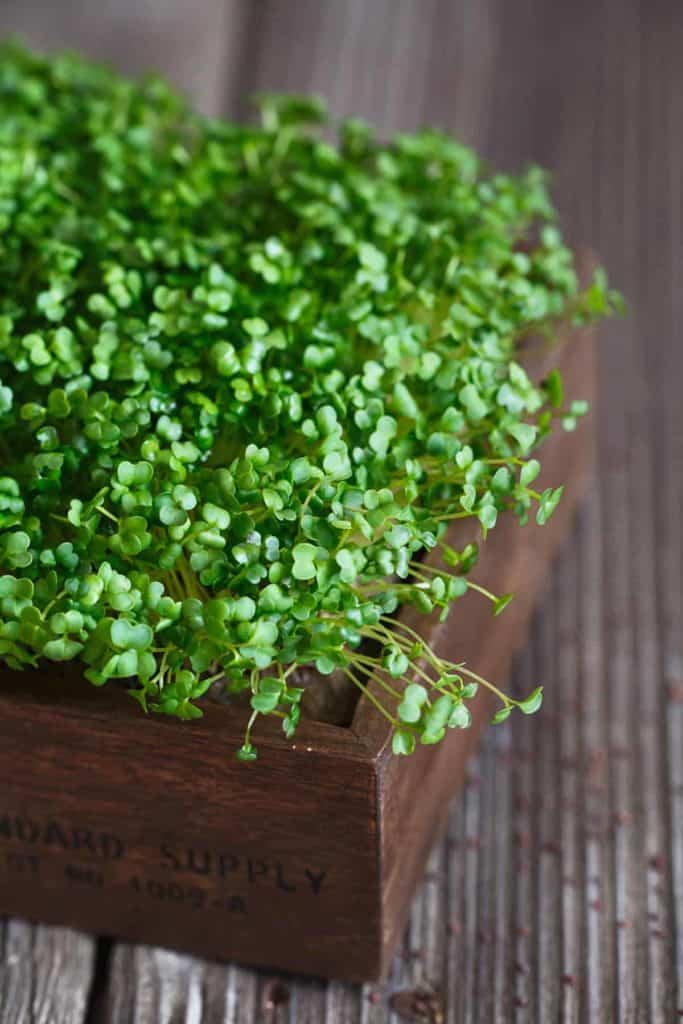
Credit: Deposit Photos
3) Broccoli microgreens
- Time to harvest: 5–14 days
- Quick growing; it’s important to bottom water these to avoid bacteria problems at the roots.
If you like the taste of regular broccoli, you’ll also like broccoli microgreens. Most people find the mild, slightly spicy flavor, and tender leaves of broccoli micros to be quite agreeable.
Plus, this popular brassica has plenty of vitamins A, B, C, E, and K, along with a fair amount of calcium, iron, protein. It has green leaves with white stems.
4) Turnip microgreens
- Time to harvest: 7–14 days
- Quick and easy to grow; does fine in indirect light
Here’s another brassica to make the list. Turnip microgreens have a mild, sweet and slightly tangy flavor—very similar to cabbage. If you don’t like the sharp taste of full-grown turnips, you’ll be happy to know that the microgreens are much milder.
Many turnip varieties actually don’t need as much light, and do fine in indirect light—a bonus if you don’t have grow lights at home.
Turnips are a good source of iron, Vitamins C, K, and E, and beta-carotenes.
5) Bok choy microgreens
- Time to harvest: 8 to 11 days
- Quick and easy to grow; does fine in lower light
Sometimes called pak choi, bok choy has a fresh and mild flavor that’s slightly sweet, yet earthy. Sometimes bok choy is confused with Napa cabbage: these two Asian vegetables are both brassicas, but are slightly different. Fully grown bok choy has darker green coloring and doesn’t really resemble a cabbage at all with its elongated shape.
Boy choy is easy to grow and still thrives even in lower light conditions—this is one of the reasons why boy choy is such a delight to grow.
Add to salads, sandwiches, or eat on its own. Bok choy is chock-full of vitamins C and E, and beta-carotene.
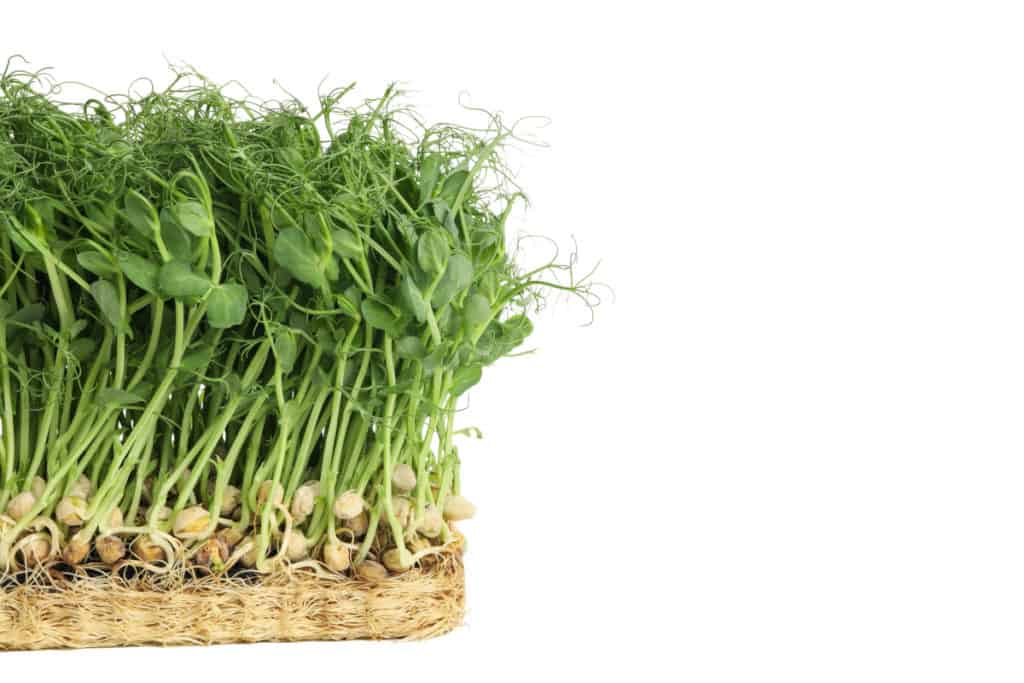
Credit: Yay Images
6) Pea shoot microgreens
- Time to harvest: 8–12 days
- Quick and easy to grow; high germination rates
There are many varieties of peas, but most pea microgreens are pretty substantial and make a satisfying snack. Crunchy and slightly sweet, pea shoot microgreens make a wonderful salad base and pair nicely with sunflower microgreens.
You really can’t go wrong with pea microgreens—just plant and harvest. Pea shoots are also one of the rare microgreens that can regrow after harvesting so you can enjoy a second (possibly a third) harvest.
Peas shoot microgreens are a great source of antioxidants, beta-carotene, and vitamin K.
7) Cress microgreens
- Time to harvest: 7–14 days
- Fast grower; cress is a mucilaginous seed
Some like it hot…if you’re looking to add some kick to your favorite dishes, cress may be just what you’re looking for. Sprinkle cress microgreens to add an extra flavor dimension to dishes. Use as a garnish, or in dishes sparingly.
Cress is a mucilaginous seed which means it forms a gel-like sac around each seed when wet. Avoid overwatering as this will result in low germination.
Cress is a good source of vitamins B, C, and K, along with folic acid and fiber.
8) Lettuce (romaine) microgreens
- Time to harvest: Less than 14 days
- Fragile after harvest; quick germination even in cooler temperatures
While there are many varieties of lettuce, romaine lettuce microgreens are great to grow because you can harvest earlier for microgreens, or later to allow them to reach the baby greens stage.
The mild, agreeable flavor of romaine microgreens (which essentially taste just like the mature version) pairs well with anything. Add to salads, wraps, and sandwiches.
Romaine lettuce contains vitamins C and K, along with minerals such as folate and calcium.
9) Komatsuna
- Time to harvest: 8–12 days
- Grows rapidly and evenly; tolerates heat and cold; avoid overcrowding the seeds
Komatsuna, sometimes called Japanese mustard spinach is perfect if you like a milder mustard flavor without the kick. Because it lacks the spiciness of other mustard greens, you can use it more readily in a variety of dishes.
Komatsuna has a bright green top with a white stem. A source of vitamins A, C, E, and K, along with fiber and antioxidants.
10) Sesame microgreens
- Time to harvest: 7–10 days
- Germinates quickly
When choosing sesame seeds, the beige seeds rather than black seem to grow better. Sesame microgreens have a slightly nutty and mild flavor. The microgreens have bright green leaves and pale white to light-green stems.
Sesame microgreens contain vitamins B, C, E, as well as antioxidants, protein, and folate.
While most microgreens don’t do well when cooked, the flavor of sesame is enhanced when lightly cooked.
11) Endive microgreens
- Time to harvest: 8–15 days
- Easy to grow; tolerates colder temperatures
This pale-green microgreen has a mild flavor with a slightly bitter aftertaste. This makes it a nice counterpart to other flavors that are salty or sweet.
While each green doesn’t grow very tall, it tends to grow wider.
Use as a lettuce replacement in sandwiches and wraps. Endive microgreens are a source of vitamins A, C, and K, plus beta-carotene and folate.
12) Mustard microgreens
- Time to harvest: 7–8 days
- Quick and easy to grow; grows uniformly
If you’re looking for a spicy green to liven up your dishes, mustard microgreens won’t disappoint. While there are many varieties of mustard greens, most have a bold, intense flavor similar to horseradish, which you’ll want to use in small quantities as a garnish.
Most mustard greens prefer growing temperatures slightly on the warmer side with ample light. Mustard microgreens contain vitamins A,C, E, and K, plus fiber and protein.
13) Wheatgrass microgreens
- Time to harvest: 6–10 days
- Quick and easy to grow; great for juices and smoothies
Admittedly, the taste of wheatgrass may not be everyone’s cup of tea, but wheatgrass is great in smoothies or juices, and grows easily. What does wheatgrass taste like? Pretty much like grass (or what you would think grass tastes like, assuming you’ve never munched on any!). It has a fresh and intense flavor.
One of the healthiest microgreens, wheatgrass contains vitamins A, B, C, E and K, and a fair amount of protein. It’s a source of calcium, iron, magnesium, phosphorous, potassium, and amino acids.
Check out our article on making healthy microgreen smoothies.
Intermediate microgreens to grow
A little more challenging to cultivate for a variety of reasons than the microgreens listed above, here’s a roundup of intermediate microgreens to grow.
While some are more difficult to grow, don’t be afraid to give it a try!
| Microgreen | Time to Harvest | Growing Characteristics | Taste and Use |
|---|---|---|---|
| Beet and chard | 11–21 days | More difficult to germinate, but grows easily. | Adds a bright splash of color with red varieties. |
| Carrot | 14–20 days | Challenging to grow. | Slightly sweet. |
| Cilantro | 21–28 days | More difficult to germinate (even more difficult than dill and fennel). | Amazing taste with a splash of citrus flavor. |
| Fennel and dill | 10–14 days | More difficult to germinate. | Great tasting similar to full grown herbs. |
| Red Russian kale | 8–12 days | Grows slowly. | A beautiful microgreen to behold at all stages of growth; adds a splash of color. |
| Sorrel and marjoram | Up to 30 days | Grows slowly, quite leafy. | Distinct flavor. |
| Sunflower (black oil seeds) | 8–12 days | Sometimes has trouble taking root; need to pre-soak and germinate the seeds before sowing. | Pleasant mild and nutty flavor with crunch. |
| Sweet basil | 14–21 days | Grows slowly and is a bit fussy (doesn’t like extreme temperatures). | One of the most pleasant flavors —slightly sweet with a hint of cloves. |
| Thai basil | 18–30 days | Grows slowly and is a bit fussy (doesn’t like extreme temperatures); has mucilaginous seeds. | An intense basil flavor with a hit of licorice. |
👉 If you like this post, see our Complete Guide to Growing Microgreens at Home. 🌱
Would you like more timeless tips via email?
Fun tips to help you live an independent, self-sustaining lifestyle. Opt-out at any time.


References
- Public Broadcasting Service (PBS), Modern Gardener, Growing Microgreens and Sprouts Part 3: Growing and Eating, https://www.pbs.org/video/growing-microgreens-and-sprouts-part-3-growing-and-eating-45doaj/. Accessed July 2021.
- Braunstein, Mark Mathew (2013). Microgreen Garden: Indoor Grower’s Guide to Gourmet Greens. Book Publishing Company. ISBN 13: 978-1-57067-294-1.
- Lester, Gene & Xiao, Zhenlei & Luo, Yaguang & Wang, Qin. (2013). Microgreens: Assessment of Nutrient Concentrations. Journal of Agricultural and Food Chemistry. Accessed April 2021.

Author: Josh Tesolin
Josh is co-founder of RusticWise. When he’s not tinkering in the garden, or fixing something around the house, you can find him working on a vast array of random side projects.

